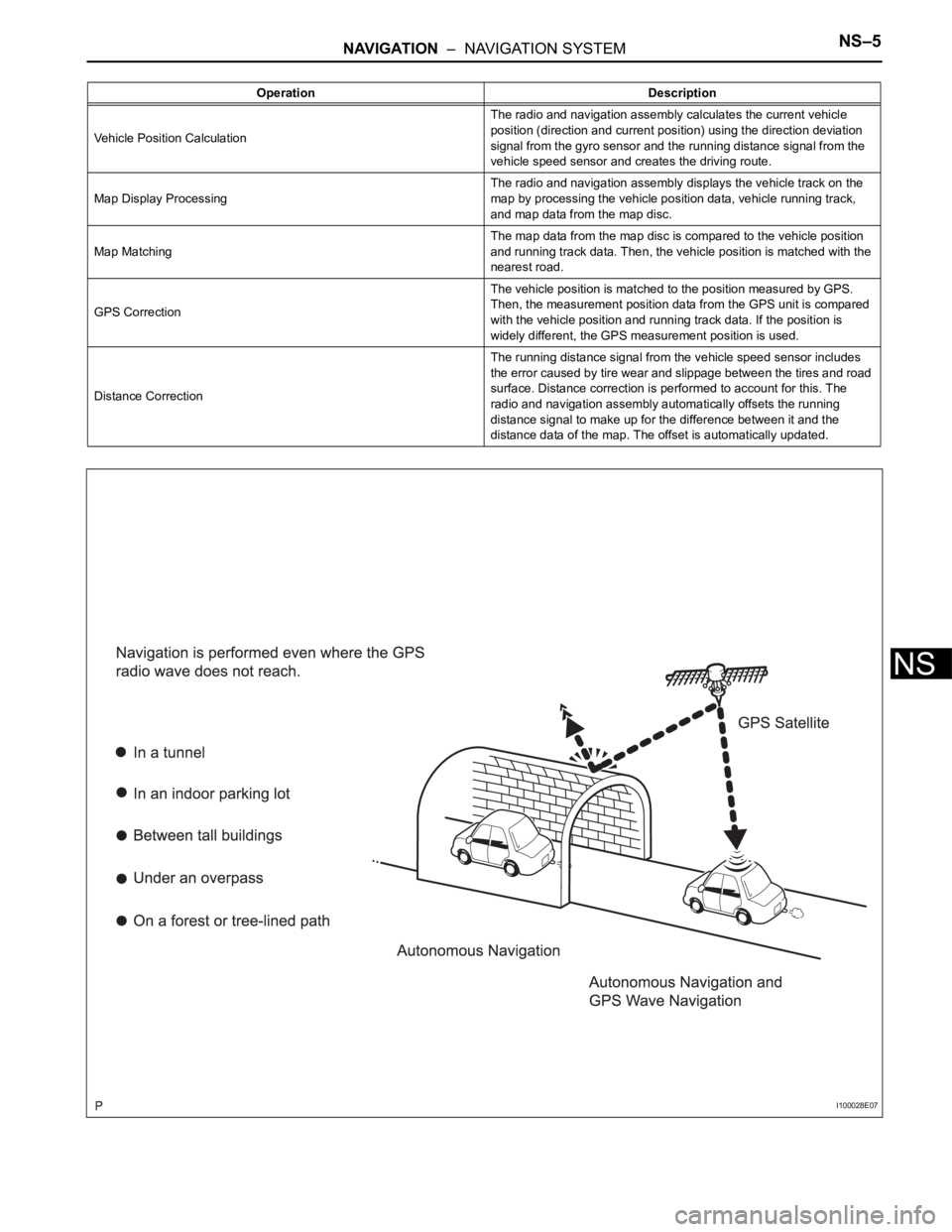2007 TOYOTA SIENNA sensor
[x] Cancel search: sensorPage 266 of 3000

NAVIGATION – NAVIGATION SYSTEMNS–5
NS
Operation Description
Vehicle Position CalculationThe radio and navigation assembly calculates the current vehicle
position (direction and current position) using the direction deviation
signal from the gyro sensor and the running distance signal from the
vehicle speed sensor and creates the driving route.
Map Display ProcessingThe radio and navigation assembly displays the vehicle track on the
map by processing the vehicle position data, vehicle running track,
and map data from the map disc.
Map MatchingThe map data from the map disc is compared to the vehicle position
and running track data. Then, the vehicle position is matched with the
nearest road.
GPS CorrectionThe vehicle position is matched to the position measured by GPS.
Then, the measurement position data from the GPS unit is compared
with the vehicle position and running track data. If the position is
widely different, the GPS measurement position is used.
Distance CorrectionThe running distance signal from the vehicle speed sensor includes
the error caused by tire wear and slippage between the tires and road
surface. Distance correction is performed to account for this. The
radio and navigation assembly automatically offsets the running
distance signal to make up for the difference between it and the
distance data of the map. The offset is automatically updated.
I100028E07
Page 267 of 3000

NS–6NAVIGATION – NAVIGATION SYSTEM
NS
HINT:
The combination of autonomous and GPS
navigation makes it possible to display the vehicle
position even when the vehicle is in places where
the GPS radio wave cannot receive a signal. When
only autonomous navigation is used, however, the
mapping accuracy may slightly decline.
(b) Autonomous navigation
This method determines the relative vehicle position
based on the running track determined by the gyro
and vehicle speed sensors located in the radio and
navigation assembly.
(1) Gyro sensor
Calculates the direction by detecting angular
velocity. It is located in the radio and navigation
assembly.
(2) Vehicle speed sensor
Used to calculate the vehicle running distance.
Page 269 of 3000

NS–8NAVIGATION – NAVIGATION SYSTEM
NS
(d) Map matching
The current driving route is calculated by
autonomous navigation (according to the gyro
sensor and vehicle speed sensor) and GPS
navigation. This information is then compared with
possible road shapes from the map data in the map
disc and the vehicle position is set onto the most
appropriate road.
I100030E07
Page 282 of 3000

WINDSHIELD / WINDOWGLASS – POWER WINDOW CONTROL SYSTEM (w/ Jam Protec-
tion Function)WS–7
WS
INITIALIZATION
NOTICE:
• Resetting the power window motor (initializing the
pulse sensor) is necessary when the battery terminal
is disconnected; when the master switch, wire
harness, power window regulator and power window
motor are replaced or removed/installed; or when the
fuses are replaced. AUTO operation function, jam
protection function and remote operation function via
the power window master switch do not operate
without resetting.
• If the AUTO switch (driver side switch) of the master
switch has been continuously operated for a long
time, the power window motor will stop so that no
additional load can be applied to the motor.
Continuing to operate the switch even after the motor
has stopped will cause the switch to blink while
restricting the AUTO UP/DOWN function and the
remote UP/DOWN function. If this happens, reset the
motor again after several minutes have passed.
• Whenever disconnecting the battery terminal, reset all
the other systems besides the power window control
system.
1. RESET POWER WINDOW REGULATOR MOTOR
(DRIVER SIDE)
(a) Turn the ignition switch ON.
(b) Halfway open the power window by pressing the
power window switch.
(c) Fully pull up the switch until the power window is
fully closed and continue to hold the switch for
approx. 1 second after the power window is fully
closed.
(d) Check that the AUTO UP/DOWN function operates
normally.
If the AUTO UP/DOWN function operates normally,
reset operations have been completed at this time.
If not normal, follow steps below.
(1) Disconnect the negative battery terminal for 10
seconds.
(2) Connect the battery terminal.
(3) Perform the above steps (a) to (d) again.
HINT:
If operation is normal, reset operations have
been completed at this time. If not normal, follow
steps (4) to (7).
(4) Turn the ignition switch ON.
(5) Halfway open the power window by pressing the
power window switch.
(6) Fully pull up the switch until the power window is
fully closed and continue to hold the switch for
approx. 12 seconds after the power window is
fully closed.
(7) Check that the AUTO UP/DOWN function
operates normally.
Page 318 of 3000

2GR-FE ENGINE CONTROL SYSTEM – SFI SYSTEMES–1
ES
SFI SYSTEM
PRECAUTION
1. INITIALIZATION
NOTICE:
• Perform RESET MEMORY (AT initialization) when
replacing the automatic transaxle assembly, engine
assembly or ECM (See page AX-16).
• Perform REGISTRATION (VIN registration) when
replacing the ECM (See page ES-15).
HINT:
Initialization cannot be completed by only removing the
battery.
2. FOR USING INTELLIGENT TESTER
CAUTION:
Observe the following items for safety reasons:
• Before using the tester, read the instruction
manual.
• Prevent the tester cable from being caught on the
pedals, shift lever and steering wheel when
driving with the tester connected to the vehicle.
• When driving the vehicle for testing purposes
using the tester, two persons are required. One is
for driving the vehicle, and the other operates the
tester.
3. FOR USING BATTERY DURING INSPECTION
(a) While using the battery during inspection, do not
bring the positive and negative tester probes too
close to each other as a short circuit may occur.
4. COOLING FAN SYSTEM
NOTICE:
• When the ignition switch is turned off and the engine
temperature is high, the cooling fans may operate for
approximately 3 minutes.
• After turning the ignition switch off, keep hands and
objects away from the fans when they are operating.
HINT:
If all of the following are met for a certain period of time during
a few minute period immediately before the engine is
stopped, the electric fans will continue to operate for 3
minutes after the engine is stopped. This is performed to
ensure restartability and stabilize idle speed.
– The intelligent tester indicates a very high coolant
temperature.
– The intelligent tester indicates a high outside air
temperature.
– The vehicle has been driven under high load (driving on an
uphill or equivalent).
The following sensors are used for this control:
– Coolant temperature sensor
– Outside air temperature sensor
–MAF sensor
– Vehicle speed sensors
Page 319 of 3000

ES–22GR-FE ENGINE CONTROL SYSTEM – SFI SYSTEM
ES
DEFINITION OF TERMS
Terms Definitions
Monitor Description Description of what ECM monitors and how to detect malfunctions (monitoring purpose and details).
Related DTCs A group of diagnostic trouble codes that are output by ECM based on the same malfunction detection logic.
Typical Enabling
ConditionsPreconditions that allow ECM to detect malfunction.
With all preconditions satisfied, ECM sets DTC when monitored value(s) exceeds malfunction threshold(s).
Sequence of OperationOrder of monitor priority, applied if multiple sensors and components are involved in single malfunction detection
process.
Each sensor and component monitored in turn and not monitored until previous detection operation is completed.
Required Sensors /
ComponentsSensors and components used by ECM to detect each malfunction.
Frequency of OperationNumber of times ECM checks for each malfunction during each driving cycle.
"Once per driving cycle" means ECM performs checks for that malfunction only once in single driving cycle.
"Continuous" means ECM performs checks for that malfunction whenever enabling conditions are met.
DurationMinimum time for which ECM must detect continuous deviation in monitored value(s) in order to set DTC. Timing
begins when typical enabling conditions are met.
Malfunction Thresholds Values, beyond which, ECM determines malfunctions exist and sets DTCs.
MIL OperationTiming of MIL illumination after defect is detected.
"Immediate" means ECM illuminates MIL as soon as malfunction is detected.
"2 driving cycles" means ECM illuminates MIL if the same malfunction is detected twice during the next sequential
driving cycle.
Page 320 of 3000

ES–2522GR-FE ENGINE CONTROL SYSTEM – SFI SYSTEM
ES
DESCRIPTION
The exhaust camshaft's Variable Valve Timing (VVT) sensor consists of a magnet and MRE (Magneto
Resistance Element).
The exhaust camshaft has a sensor plate with 3 teeth on its outer circumference.
When the exhaust camshaft rotates, changes occur in the air gaps between the 3 teeth and MRE, which
affects the magnet. As a result, the resistance of the MRE material fluctuates. The VVT sensor converts
the exhaust camshaft rotation data to pulse signals, uses the pulse signals to determine the camshaft
angle, and sends it to the ECM.
MONITOR DESCRIPTION
If no signal is transmitted by the VVT (for exhaust camshaft) sensor despite the engine revolving, or the
rotations of the exhaust camshaft and the crankshaft are not synchronized, the ECM interprets this as a
malfunction of the sensor.
DTC P0365 Camshaft Position Sensor "B" Circuit (Bank 1)
DTC P0367Camshaft Position Sensor "B" Circuit Low
Input (Bank 1)
DTC P0368Camshaft Position Sensor "B" Circuit High
Input (Bank 1)
DTC P0390 Camshaft Position Sensor "B" Circuit (Bank 2)
DTC P0392Camshaft Position Sensor "B" Circuit Low
Input (Bank 2)
DTC P0393Camshaft Position Sensor "B" Circuit High
Input (Bank 2)
DTC No. DTC Detection Condition Trouble Area
P0365
P0390• Input voltage to ECM remains 0.3 V or less, or 4.7
V or higher for more than 5 seconds, when 2 or
more seconds have elapsed after turning ignition
switch ON position
(1 trip detection logic)
• No VVT sensor signal to ECM during cranking
(1 trip detection logic)• Open or short in VVT sensor for exhaust camshaft
circuit
• VVT sensor for exhaust camshaft
• Exhaust camshaft
• Jumped tooth of timing chain
•ECM
P0367
P0392Output voltage of VVT sensor is 0.3 V or less for 5
seconds
(1 trip detection logic)• Open or short in VVT sensor for exhaust camshaft
circuit
• VVT sensor for exhaust camshaft
• Exhaust camshaft
• Jumped tooth of timing chain
•ECM
P0368
P0393Output voltage of VVT sensor is 4.7 V or more for 5
seconds
(1 trip detection logic)• Open or short in VVT sensor for exhaust camshaft
circuit
• VVT sensor for exhaust camshaft
• Exhaust camshaft
• Jumped tooth of timing chain
•ECM
Page 321 of 3000

2GR-FE ENGINE CONTROL SYSTEM – SFI SYSTEMES–253
ES
MONITOR STRATEGY
TYPICAL ENABLING CONDITIONS
All:
Exhaust Camshaft Sensor Range Check / Rationality (While starting engine):
Exhaust Camshaft Sensor Range Check / Rationality (After starting engine):
Exhaust Camshaft Sensor Range Check (Chattering, Low voltage, High voltage):
TYPICAL MALFUNCTION THRESHOLDS
Exhaust Camshaft Sensor Range Check / Rationality (While starting engine):
Exhaust Camshaft Sensor Range Check / Rationality (After starting engine):
Exhaust Camshaft Sensor Range Check (Chattering):
Related DTCsP0365: Exhaust camshaft sensor (Bank 1) range check / rationality (while starting
engine)
P0365: Exhaust camshaft sensor (Bank 1) range check / rationality (after starting
engine)
P0365: Exhaust camshaft sensor (Bank 1) range check (chattering)
P0367: Exhaust camshaft sensor (Bank 1) range check (low voltage)
P0368: Exhaust camshaft sensor (Bank 1) range check (high voltage)
P0390: Exhaust camshaft sensor (Bank 2) range check / rationality (while starting
engine)
P0390: Exhaust camshaft sensor (Bank 2) range check / rationality (after starting
engine)
P0390: Exhaust camshaft sensor (Bank 2) range check (chattering)
P0392: Exhaust camshaft sensor (Bank 2) range check (low voltage)
P0393: Exhaust camshaft sensor (Bank 2) range check (high voltage)
Required Sensors / Components (Main) Exhaust camshaft sensor (Bank 1 and 2)
Required Sensors / Components (Related) Exhaust camshaft sensor
Frequency of Operation Continuous
Duration5 seconds: Exhaust camshaft sensor range check / rationality (After starting engine)
4 seconds: Others
MIL Operation2 driving cycles: Exhaust camshaft sensor range check / rationality (After starting
engine)
Immediate: Others
Sequence of Operation None
The monitor will run whenever these DTCs are not
presentNone
Sta r t e r ON
Battery voltage while starter is ON at least once Less than 11 V
Engine RPM 600 rpm or more
Sta r t e r OF F
Battery voltage 8 V or more
Ignition Switch ON
Sta r t e r OF F
Ignition Switch ON and time after ignition switch is OFF
to ON2 seconds or more
Battery voltage 8 V or more
Exhaust camshaft sensor signal No signal
Exhaust camshaft sensor signal No signal
Exhaust camshaft sensor signal Less than 0.3 V, or more than 4.7 V